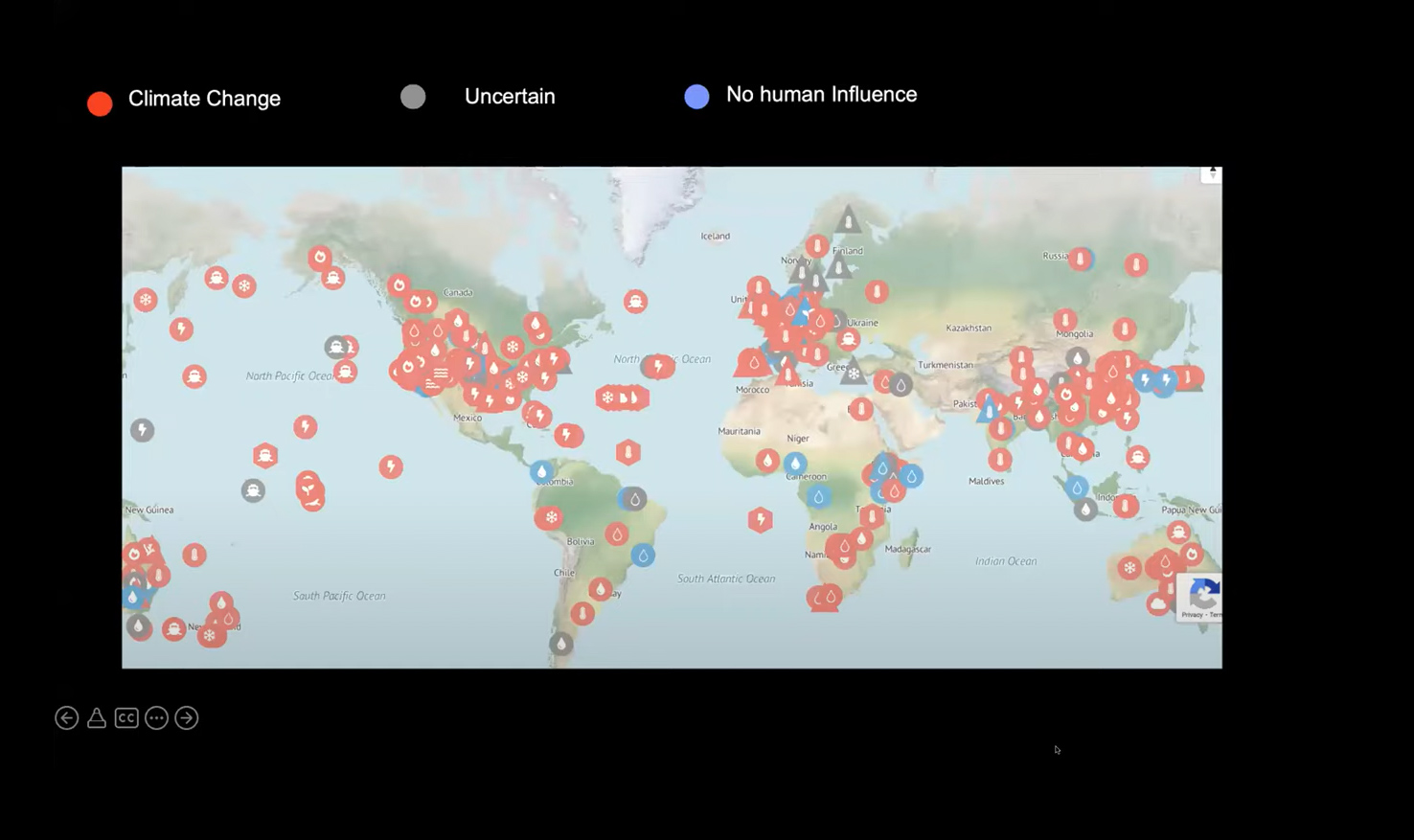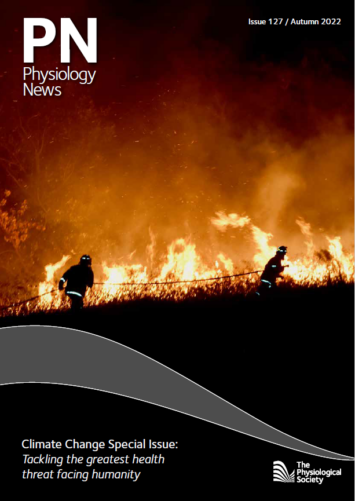
Physiology News Magazine
Colossal changes in climate threaten our liveable future
Catastrophe is on the horizon; we must act fast and hard to secure our survival
Features
Colossal changes in climate threaten our liveable future
Catastrophe is on the horizon; we must act fast and hard to secure our survival
Features

https://doi.org/10.36866/pn.127.16
Professor Hugh Montgomery
Professor of Intensive Care Medicine, University College London
Climate change is the greatest threat facing humanity. From heatwaves, storms and rising sea levels to floods, droughts, and fires, our world is under attack from a climate of our own making. The downstream impacts of climate change on health are already being felt around the world. Our current trajectory commits us, within decades, to a mass extinction event to rival those in Earth’s history. We have ignored the warnings. There is no time left. We must all act now.
How did we get here? Ignorance is bliss
For over a century, we have been burning fossil fuels (namely oil, coal, and “natural” gas [mainly methane]) to generate the energy we need to heat and power our homes, cars and businesses. Use has increased exponentially over time. In 2019, 84% of the world’s energy consumption needs were met by fossil fuels (BP, 2020), and low-carbon sources are merely supplementing escalating fossil fuel use, rather than displacing it. Despite a slight COVID-19 related dip in 2020, use increased in 2021 and continues to steeply rise. And we are paying the price. When fossil fuels are burned, large quantities of carbon dioxide (CO2) are produced: 36 trillion kilograms last year alone (each kg representing over 500 litres of volume). Atmospheric concentrations are thus rising by 2.6 ppm each year. Carbon dioxide is a greenhouse gas (GHG), allowing shortwave solar radiation to pass through it, but trapping long-wave radiation from surface warming. Human activity (fossil fuel extraction, and our food system) also adds methane to the atmosphere, a GHG that is 93 times more powerful than CO2 in its first 20 years (EDF, no date).
Since 1998, GHGs have trapped the energy equivalent of nearly 50 billion Hiroshima bombs in our oceans and gaseous atmosphere, and we continue to trap the equivalent of five more every second (Holmes, 2013). And this effect doesn’t cease even when emissions do. One fifth of the CO2 we release today will remain in our atmosphere, cooking us in 33,000 years, and 7% will still be in the atmosphere cooking us in 100,000 years.
During the last century we have been burning through fossil fuels, we have also been ignoring the warning signs that they are drivers of climate change. In 1896, a seminal paper by Swedish scientist Svante Arrhenius published in Philosophical Magazine first predicted that changes in atmospheric CO2 levels could substantially alter the surface temperature through the greenhouse effect (Arrhenius, 1896). Then, 27 years ago, in March 1995 the first United Nations Climate Change conference was held. Since then, member state representatives have met annually (bar 2020) at the Conference of the Parties (COP). Their warnings, and calls for action to limit emissions, have become ever more strident, as has the Intergovernmental Panel on Climate Change (IPCC) reports from the world’s scientists. But all these warnings have been ignored. So, what does this mean for life on this planet?

What’s cooking? Fire
Human activity has raised global mean surface temperatures by 1.1oC from pre-industrial levels. This sounds insignificant, until one considers the huge amount of energy required to do this. Add energy to an atmosphere, and you get weather. Rising temperatures increase concentrations of ground-level ozone and extend the pollen season, both damaging respiratory health. Together with altered rainfall patterns, warming increases exposure to vector-borne disease such as Dengue fever.
The more energy added, the more extreme weather events will occur, and the more extreme they will be. As a consequence, extreme weather events are becoming more frequent and more severe (Fig.1). As I write this, the UK is experiencing its hottest weather on record. For the first time in history, we saw temperatures climb to over 40oC. But records have been broken in the rest of Europe too, as well as in China, Japan, North and South America. Such heatwaves impact on crop production as well as the ability to work outside, and thus on food availability and health. Heat also causes excess cardiovascular deaths, especially in vulnerable populations such as the young, old, or infirm.
A hotter atmosphere can also hold more moisture, thus desiccating soil. Add heatwaves, and fires result, destroying homes, habitats and lives. Looking back at the past two years alone, we’ve seen escalating fires in the Amazon, Angola, Australia, California, Canada, Colorado, The Congo, Indonesia, Greece, Italy and Spain. Particulates from these fires impact human cardiorespiratory health, and may also increase the risk of other diseases such as cancers and dementia.
Floods
Rising temperatures (Fig.2) also have devastating effects on our sea levels. Extreme weather events (low pressure) also cause extreme transient rises, with flooding augmented by associated dense rainfall. Ocean heating leads to thermal expansion and thus a rise in sea levels, as does melting of land ice, and this is accelerating. Alarming temperatures were recently recorded at the Poles. In March 2022, the Antarctic reached 40oC above its normal temperature range between −10oC and −60oC and climbed to 47oC higher a day later, while at the same time the Arctic hit 30oC degrees above normal (around 10oC to -30oC). Temperatures in the Arctic breached +32oC in July. The ice shelf on the west of Greenland alone is producing 1.1 million metric tonnes of melt water a minute (Tedesco and Fettweis, 2019). Overall, sea levels are now rising by a centimetre every two years (IPCC, 2013).
Heating causes more evaporation and warm air can hold more water. On cooling, that water is released as dense rainfall, with the latent heat of evaporation driving ever more powerful storms. The frequency and intensity of tropical cyclones (hurricanes, and typhoons), floods, and unusually heavy rainfall events are rising and will continue to do so (IPCC 2021; U.S. Global Change Research Program 2018). Last summer saw floods across Europe, including Belgium, Germany and the UK and at the end of August, with tens of thousands similarly affected in China. This year saw record rainfall and floods worldwide, from Valencia (Spain) to Kwazulu Natal (South Africa). Habitats, infrastructure and crops are impacted ever more severely. Floods can flush vast amounts of fertiliser, sewerage, and manure into waterways, causing disease and poisonous algal blooms (cyanobacteria) to occur (Anderson et al., 2002).

The double punch
The combination of drought and fire, then floods have been named the double punch, the consequences of which are far reaching; fires destroy the roots of crops and vegetation and then the lack of structure and soil anchorage means that floods can cause landslides with devastating loss of land and life. The harsh reality of this was seen in British Columbia before Christmas last year, where 18,000 people were displaced.
Critical condition – are we nearing a point of collapse?
We are currently seeing the harmful effects of a 1.1oC increase in temperature since 1880 (Schwalm et al., 2020). The Met Office has warned that there is a 50% chance of us punching through the 1.5oC mark in the next three to four years. 1.5oC is catastrophically dangerous. Even if we do lower carbon emissions, the IPCC Working Group have explained that we are locked into progressive climate change, the effects ongoing for the next thousands of years.
But it is worse than this. We have triggered, or soon may trigger, a raft of positive feedback loops. In 2019, the fires in Australia contributed 2.5% of global CO2 emissions (Byrne B et al., 2021) trapping yet more heat to cause yet more fires. Loss of the reflective surface of snow and ice as it melts, with exposure of darker soil and water beneath, has doubled the rate of earth’s energy gain in only the last 14 years. Warming causes methane to be released from stores in frozen tundra and from carbonate rocks, as well as from warming wetlands. Fires release carbon monoxide, destroying atmospheric hydroxyl radicals, which would normally mop up methane thus extending its atmospheric half-life. Further, weather systems can change from one binary state to another. Thus, the water-transporting jet stream will likely stabilise in a northerly position within decades, rendering the whole Iberian Peninsula devoid of significant rainfall, and depositing that water in Northern Europe (Cresswell-Clay N et al., 2022; Gallego et al., 2011). The split in the jetstream, which caused Northern Europe’s heatwaves of 2022, may become more permanent. The Atlantic Meridional Overturning Circulation, which brings warm water from the Pacific past UK shores as the Gulf stream, may have largely faltered within decades.
Catastrophe is nigh, but there is time to mitigate this if we act fast and hard and that includes physiologists, whether through their personal, political or professional lives. To limit global temperature rise to (a still catastrophic) 1.5oC requires that we all reduce our emissions by 50% by 2030. The Physiological Society has some suggestions on what you can do (The Society, 2022). We cannot rely on politicians to deliver. 26 COP negotiations have not resulted in any reduction in emissions at all. Not only do we need to urgently lower emissions, but we also need to figure out how we cope with the wicked, complex change in the physiological environment in which we all will be living. We must all act now to secure a liveable future. If we fail to act now, to quote the IPCC, we miss a rapidly closing window to secure a liveable future.
References
Anderson DM et al. (2002) Harmful algal blooms and eutrophication: Nutrient sources, composition, and consequences. Estuaries 25, 704–726. https://doi.org/10.1007/BF02804901
Arrhenius S et al. (1896). on the influence of carbonic acid in the air upon the temperature of the ground Philosophical Magazine and Journal of Science 5; 41, 237-276.
BP (2020). Statistical Review of World Energy 2020 https://www.bp.com/content/dam/bp/business-sites/en/global/corporate/pdfs/energy-economics/statisticalreview/bpstats-review-2020-full-report.pdf
Byrne B et al. (2021). The carbon cycle of southeast australia during 2019–2020: drought, fires, and subsequent recovery. AGU Advances 2,4 https://doi.org/10.1029/2021AV000469
Cresswell-Clay N et al. (2022). Twentieth-century Azores High expansion unprecedented in the past 1,200 years. Nature Geoscience 15, 548–553. https://doi.org/10.1038/s41561-022-00971-w
EDF (no date). Methane: A crucial opportunity in the climate fight. Available at https://www.edf.org/climate/methanecrucial-opportunity-climatefight#:~:text=Methane%20has%20more%20than%2080,by%20methane%20from%20human%20actions. (Accessed July 2022)
Gallego M et al. (2011). Trends in frequency indices of daily precipitation over the Iberian Peninsula during the last century. Journal of Geophysical Research-Atmospheres 116: doi:10.1029/2010JD014255
Holmes D (2013). Four Hiroshima bombs a second: how we imagine climate change. Available at https://theconversation.com/four-hiroshima-bombs-a-second-how-we-imagineclimate-change-16387
IPCC (2013). Climate change 2013: the physical science basis. Contribution of working group i to the fifth assessment report of the intergovernmental panel on climate change
IPCC (2021). Climate change 2021: the physical science basis. Contribution of working group i to the sixth assessment report of the intergovernmental panel on climate change. Cambridge University Press. doi:10.1017/9781009157896.
Schwalm CR et al. (2020). RCP8.5 tracks cumulative CO2 emissions. Proceedings of the National Academy of Sciences of the United States of America 117(33),19656–19657.https://doi.org/10.1073/pnas.2007117117
Tedesco M, Fettweis X (2019). Unprecedented atmosphericconditions (1948–2019) drive the 2019 exceptional melting season over the Greenland ice sheet. The Cryosphere 14,1209–1223. https://doi.org/10.5194/tc-14-1209-2020
The Society 2022. The Climate Emergency: Research Gaps and Policy Priorities report. Available at: https://www.physoc.org/policy/climate-hub/ (Accessed July 2022)
U.S. Global Change Research Program 2018
